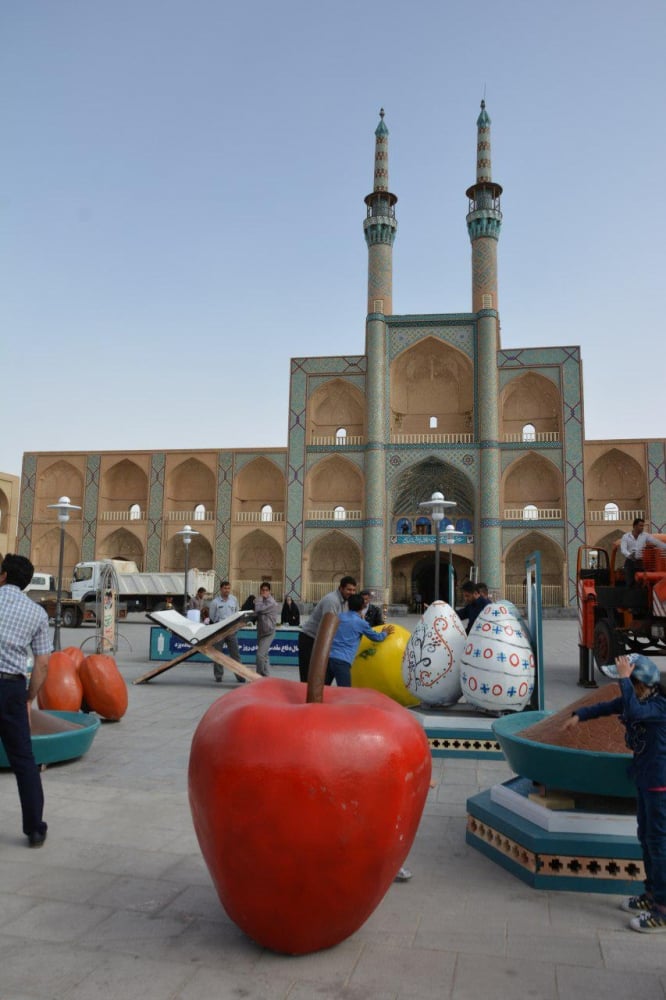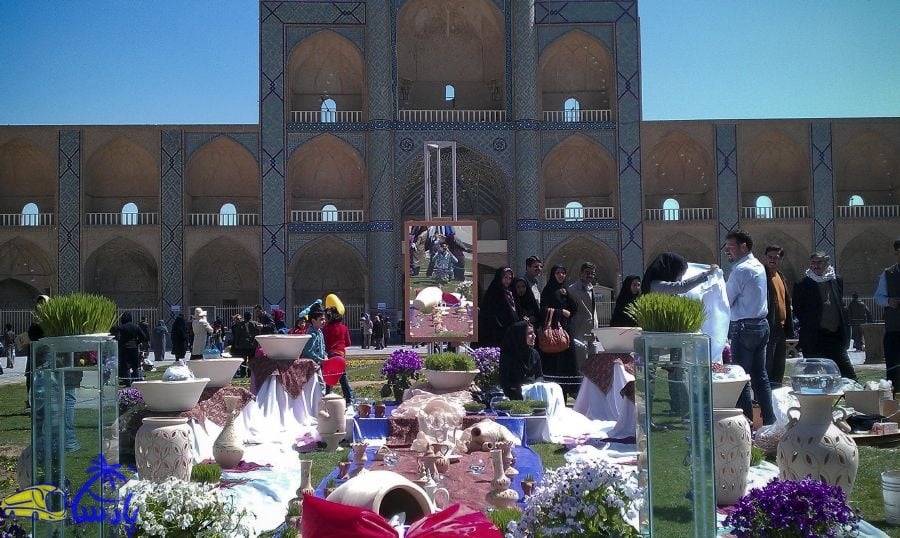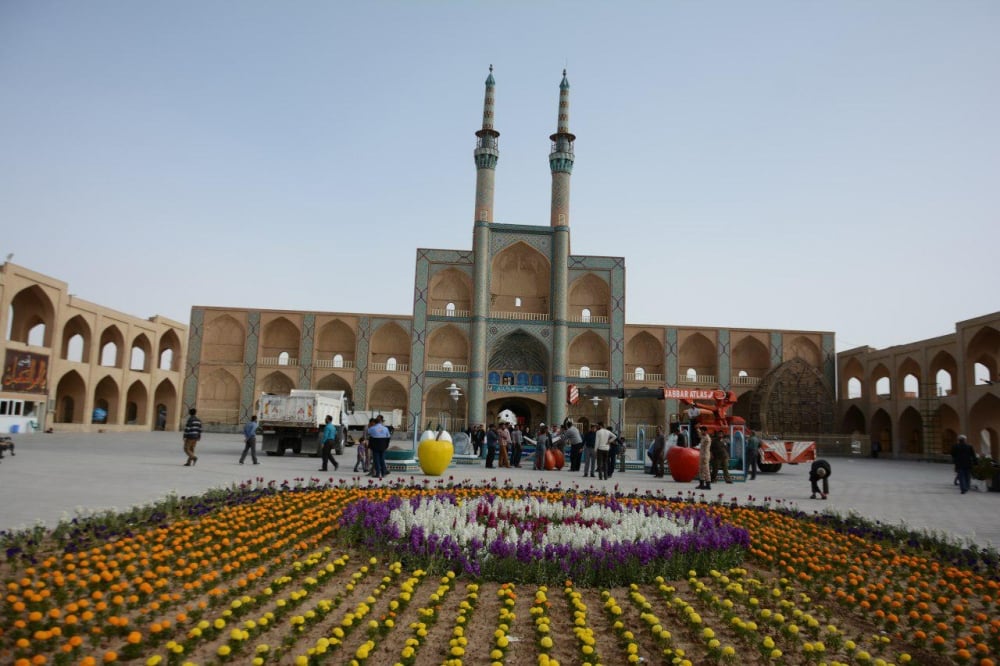Intangible or spiritual cultural heritage consists of a set of customs, representations, symbols, knowledge, skills as well as man-made things, art pieces and cultural sites widely known by the members of a society as their cultural heritage.
The heritage which is transferred from one generation to another one is represented continuously in the interactions between the societies on the one hand and their environment, nature and history on the other. The interactions provide the society members with a sense of identity which in turn paves the way for cultural pluralism.
Regardless of its unique rituals and traditions, the old city of Yazd shares Nowruz festivities with other Iranian cities as well as some neighbouring countries.
Welcoming Nowruz
At the turn of each Iranian calendar year, the people of Yazd welcome the New Year (which begins on March 20th) with colourful and joyful rituals.
Each year, about one month left to the end of the Iranian calendar year, people begin their spring cleaning. It is part of a traditional ritual to create fundamental changes in our lives.
Resorting to fortune Jar is another part of Nowruz rituals. At the turn of each year, the Iranians turn to the pottery jar to predict good and bad events of the New Year for them.
In the past, women were the ones who took the fortune jars at public or family gatherings to predict future events. Today, however, men also predict the future with the jar.
The fortune jar is of great importance in some neighbourhoods of Yazd like Rahmatabad, Maryamabad as well as Mehriz, Taft, Meibod and Ardakan towns.
Making Noodle Soup is another ritual for welcoming the New Year. Women from different neighbourhoods come together in the early morning to make the preparations for the soup. Through labour division, each group undertakes certain responsibility to prepare and distribute the soup among others by afternoon.
The soup is made mainly for asking God to grant the people’s wishes. To this effect, each woman provides an ingredient of the soup to have a share in the making of the dish.
Charshanbe Suri (Fireworks Wednesday)
Charshanbe Suri is another traditional rite which is observed by the people of Yazd ahead of the New Year. They come together at the evening of the last Tuesday of the year and eat special nuts also known as problem-solving nuts. Then they set a fire and jump over it saying “Take my yellow colour and give me your red colour.” Yellow colour is the symbol of illness and red colour a symbol of health. Meanwhile, they break their old pottery jars and buy new ones maintaining that by breaking the old jars the nastiness of the year will vanish away.
Nowruz Festivity
Haft-Seen table is one of the main pillars of Nowruz festivity. Haft-Seen is an arrangement of seven symbolic items traditionally displayed at Nowruz. It includes seven items (from nature and religion) all starting with the letter Seen (س) in the Persian alphabet.
Last year, the largest Haft-Seen table in Iran was arranged in Amir Chakhmaq Complex in Yazd – near a cemetery of the martyrs of Sacred Defence – attracting domestic and foreign tourists.
Each item in the table represents something from nature and religion.
The primary Haft-Seen items are as follows:
Sabze h (Sprouts) – wheat, barley, mung bean or lentil sprouts growing in a dish,
Samanu – sweet pudding made from wheat germ,
Senjed – dried Russian olive,
Seer – garlic,
Seeb – apple,
Somāq – sumac
Serkeh – vinegar,

As said the presence of the main items have their special meetings which are as follows:
Seeb (Apple): It symbolizes health. As the famous proverb says, “An apple a day keeps the doctor away!”
Sabzeh (Sprout): It’s a symbol of greenery, nature and exhilaration. Also there are some who claim it is a symbol of Love.
Senjed (Dried Russian olive): It symbolizes wisdom. In traditional medications Senjed was utilized to invigorate the brain and memory, and thus it is considered as wisdom symbol in Haft-Seen.
Serkeh (Vinegar): It symbolizes disinfection. Also some believe that it’s a symbol of surrendering and satisfaction.
Samanu: It has a history in pre-Islamic Persian Empire. Actually it is a symbol of power and bravery.
Somaq (Sumac): Sumac is a symbol of patience and tolerance. As a flavour, it is also viewed as a symbol of life stimulation.
Seer (Garlic): Some people consider it as a symbol of life. Also some believe that it is a symbol of peace. Also in Zoroastrian literature it is a symbol of disinfection.
On the eve of the New Year, the family members sit together around Haft-Seen table waiting for the arrival of the New Year. The elderly members of the family usually recite some special prayers immediately after the arrival of the New Year.
Some traditional dishes like Sabzi Polo (Harbed rice) with meat or fish are served on the eve of the New Year. After the arrival of the New Year, the younger generation go to their elders’ homes, congratulate them on the New Year and receive Eidi (gift).
The guests are entertained with Yazdi confectionary and chocolates and the visits continue till Sizdah Bedar (13th day of the New Year).
Sizdah Bedar
Sizdah Bedar also known as Nature’s Day is an Iranian festival held annually on the thirteenth day of Farvardin (the first month of the Iranian calendar), during which people spend time picnicking outdoors. People of Yazd go to gardens and green belts and spend their day by cheering and cooking dish for launch.
Sizdah Bedar is a special day for the new brides and engaged girls. During the day, their mothers-in-law, sisters-in-law and other relatives of the groom arrive in their homes with timbre and other musical instruments taking them for out-door picnicking.
Yazd is home to a collection of Iranian art, culture and civilization including religious sites, shrines, mosques, Zoroastrian Fire Temple, historic houses and gardens, water reservoirs, wind-catchers and Bazarcheh (local markets).
Yazd is also known as the city of wind-catchers, labour, Kariz and Kahgel, Darol Ebadeh (Place of praying), Darol Amal (place of work), bicycles, confectionary, fire and sun City, and Qanat.
Given its rich cultural and historical ties, so far at least five historical sites in Yazd including Dowlatabad Gardens, Zarch Qanats, and Pahlavanpour site as well as the city itself have been inscribed as UNESCO World Heritage sites.

